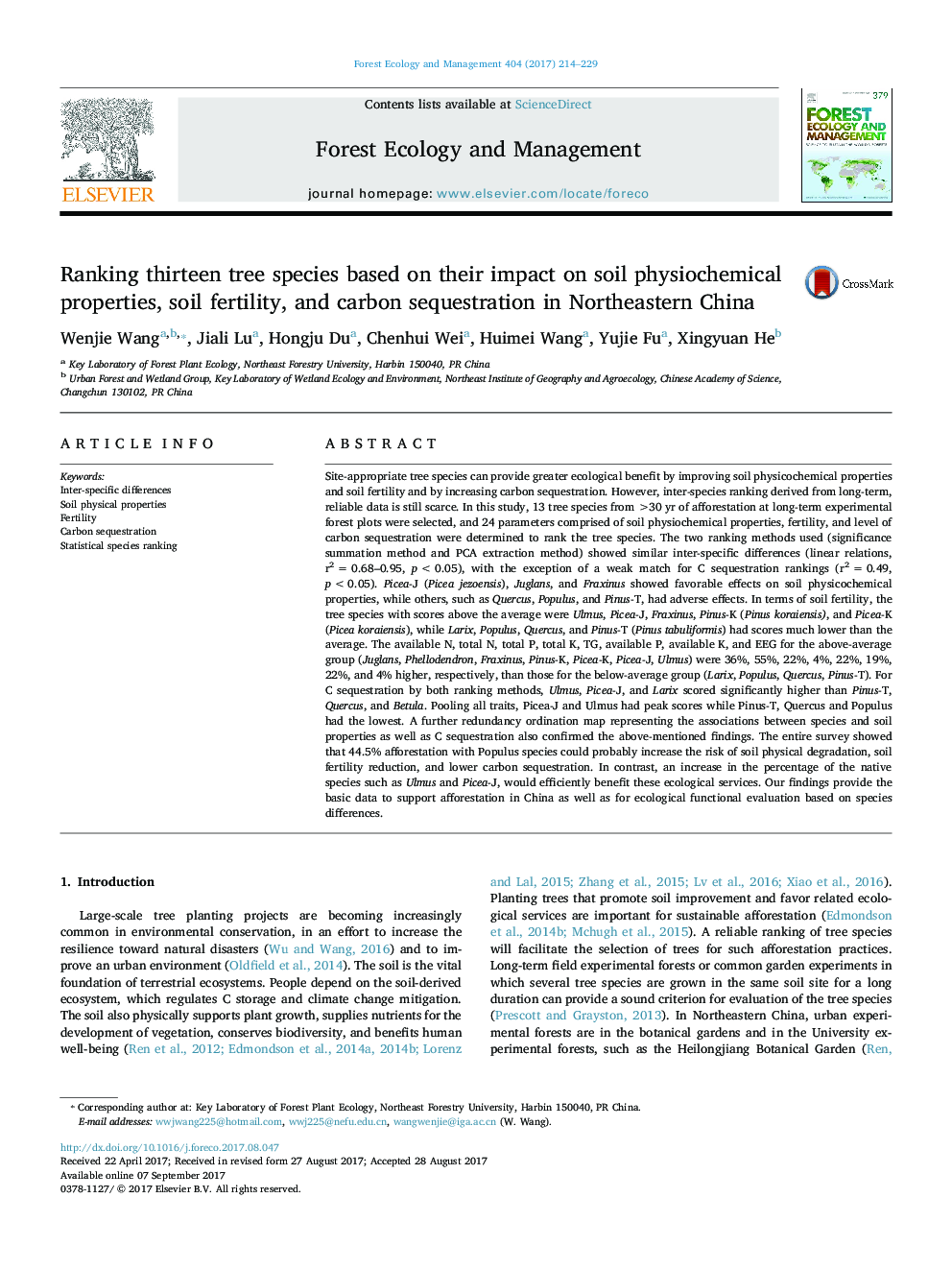| کد مقاله | کد نشریه | سال انتشار | مقاله انگلیسی | نسخه تمام متن |
|---|---|---|---|---|
| 6459163 | 1421354 | 2017 | 16 صفحه PDF | دانلود رایگان |
- A total of 13 tree species after >30-yr in the same soil were tested for 24 soil and carbon parameters.
- The 2 methods showed similar interspecific differences, as confirmed by Canoco ordinations.
- Picea jezoensis and Ulmus pumila peaked in ranking scores, while Populus was the lowest.
- Current >40% poplar in Harbin resulted in soil degradation & C sequestration reduction.
- Ulmus spp. afforestation could benefit soil improvement and carbon sink.
Site-appropriate tree species can provide greater ecological benefit by improving soil physicochemical properties and soil fertility and by increasing carbon sequestration. However, inter-species ranking derived from long-term, reliable data is still scarce. In this study, 13 tree species from >30 yr of afforestation at long-term experimental forest plots were selected, and 24 parameters comprised of soil physiochemical properties, fertility, and level of carbon sequestration were determined to rank the tree species. The two ranking methods used (significance summation method and PCA extraction method) showed similar inter-specific differences (linear relations, r2 = 0.68-0.95, p < 0.05), with the exception of a weak match for C sequestration rankings (r2 = 0.49, p < 0.05). Picea-J (Picea jezoensis), Juglans, and Fraxinus showed favorable effects on soil physicochemical properties, while others, such as Quercus, Populus, and Pinus-T, had adverse effects. In terms of soil fertility, the tree species with scores above the average were Ulmus, Picea-J, Fraxinus, Pinus-K (Pinus koraiensis), and Picea-K (Picea koraiensis), while Larix, Populus, Quercus, and Pinus-T (Pinus tabuliformis) had scores much lower than the average. The available N, total N, total P, total K, TG, available P, available K, and EEG for the above-average group (Juglans, Phellodendron, Fraxinus, Pinus-K, Picea-K, Picea-J, Ulmus) were 36%, 55%, 22%, 4%, 22%, 19%, 22%, and 4% higher, respectively, than those for the below-average group (Larix, Populus, Quercus, Pinus-T). For C sequestration by both ranking methods, Ulmus, Picea-J, and Larix scored significantly higher than Pinus-T, Quercus, and Betula. Pooling all traits, Picea-J and Ulmus had peak scores while Pinus-T, Quercus and Populus had the lowest. A further redundancy ordination map representing the associations between species and soil properties as well as C sequestration also confirmed the above-mentioned findings. The entire survey showed that 44.5% afforestation with Populus species could probably increase the risk of soil physical degradation, soil fertility reduction, and lower carbon sequestration. In contrast, an increase in the percentage of the native species such as Ulmus and Picea-J, would efficiently benefit these ecological services. Our findings provide the basic data to support afforestation in China as well as for ecological functional evaluation based on species differences.
Journal: Forest Ecology and Management - Volume 404, 15 November 2017, Pages 214-229
